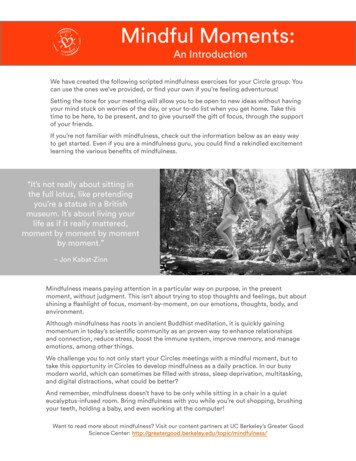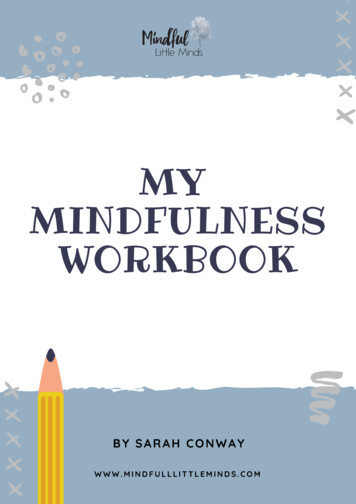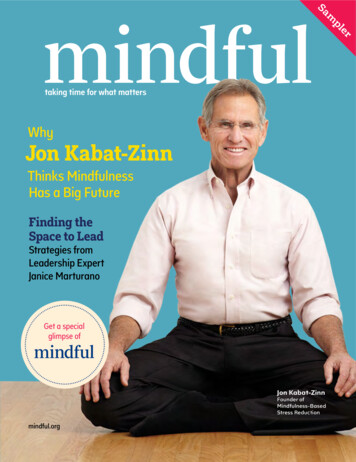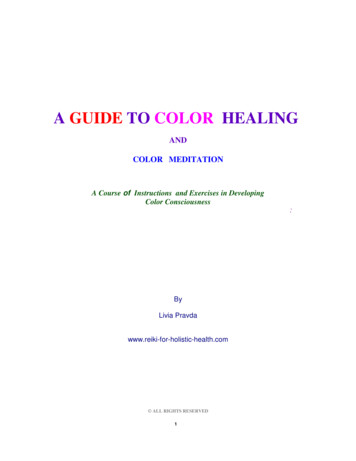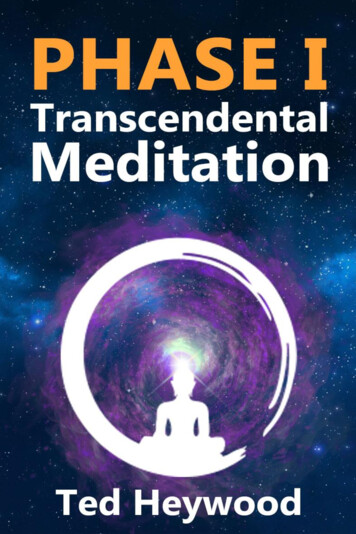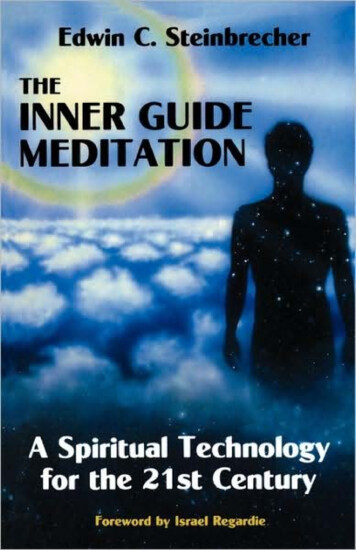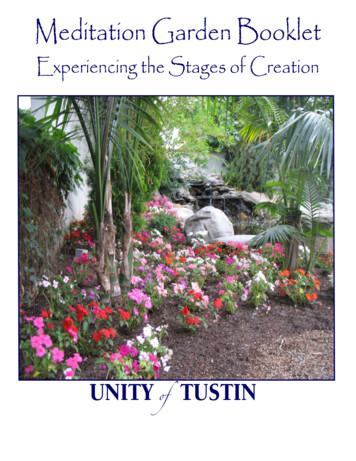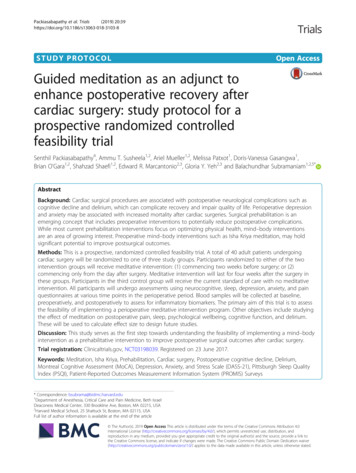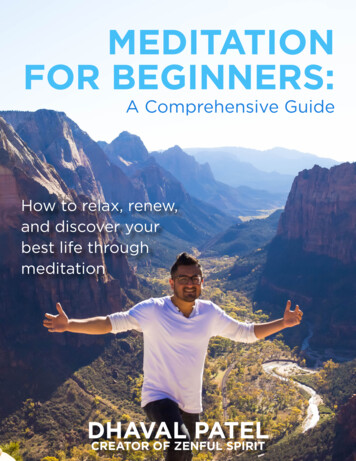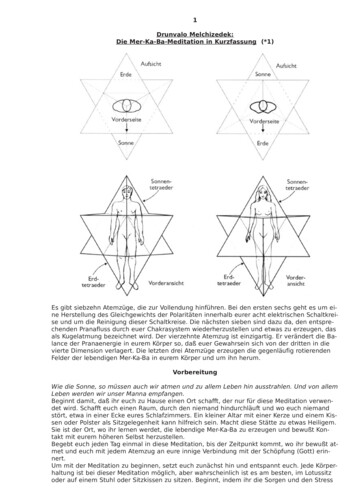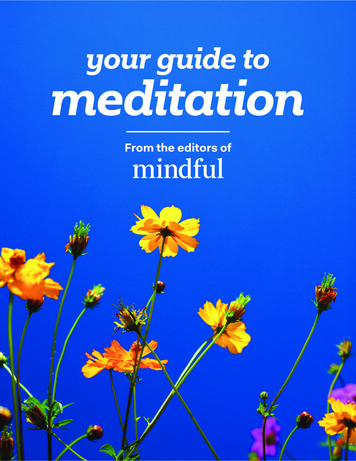
Transcription
your guide tomeditationFrom the editors of
Contents2Hit Pause and Get Going3What Is Mindfulness?5Major Myths AboutMindfulness—Debunked8How to Meditate10Posture12Don’t Psych Yourself Out13See for Yourself14You’re Already Here21S.T.O.P. Stress in Its Tracks23Embodying MindfulnessDesigned and edited by the staff of Mindful. Special thanks toSebene Selassie, Elisha Goldstein, Tara Healey, Steve Flowers,and Christiane Wolf for consulting on the content.cover photograph istock.com/ivanastarmindful 1
Hit Pause and Get GoingOver the past 24 hours, I’ve watched 16 episodes of two different TVshows on Netflix. Oh, and I’ve meditated for 20 minutes.This isn’t my usual routine. It’s Sunday evening following a particularly strenuous week of missed deadlines, rude financial awakenings, and 3a.m. wake-up calls from a rogue fire alarm. So I retreated to fictional melodramas to escape the “real” ones my mind had concocted.Twenty-four sorry hours later, I emerged from my TV coma to the sameshallow breathing and frantic worrying that punctuated my thoughts before Igrabbed the popcorn and hit the power button on my remote. I may have tunedmyself out—choosing to treat my thoughts and emotions like villains worsethan those on the screen—but that didn’t make my feelings or fixations goaway. We can’t avoid life. But with meditation, we can start to notice habitualways of thinking that pigeonhole much of our experience.So, as my weekend waned, I sat on my living room floor, set a timer, andspent some quality time with my mind. I didn’t embark on a week-long retreat,or even meditate for an hour, but I spent enough time with my mind to seethat my thoughts and mental storylines, however pesky and unrelenting, areno more solid than primetime villains, and no more worthy of fear, dread, orresistance. With practice, and the kind of guidance and insight offered in thefollowing pages, we can hone our innate ability to let go of our inner dialoguesand simply be available—what happens from there, well, that’s living. Claire Ciel Zimmerman is the associate editor of Mindful.mindful 2
mindfulnessMEDITATION: START HEREWhat IsMindfulness?When people talk aboutmindfulness, what do they reallymean? Here’s our definition.mindful 3
mindfulnessMEDITATION: START HEREMindfulness. It’s a pretty straightforward word. It suggests that the mindis fully attending to what’s happening, to what you’re doing, to the space you’removing through. That might seem trivial, except for the annoying fact that weso often veer from the matter at hand. Our mind takes flight, we lose touch withour body, and pretty soon we’re engrossed in obsessive thoughts about something that just happened or fretting about the future. And that makes us anxious.Yet no matter how far we drift away, mindfulness is right there to snap usback to where we are and what we’re doing and feeling.If you want to know what mindfulness is, it’s best to try it for a while. Sinceit’s hard to nail down in words, you will find slight variations in the meaning inbooks, websites, audio, and video. Here’s an all-purpose definition that treatsmindfulness as a quality that every human being already possesses, ratherthan something we have to conjure up:Mindfulness is the basic human ability to be fully present, aware of where weare and what we’re doing, and not overly reactive or overwhelmed by what’sgoing on around us.While mindfulness is innate, it can be cultivated through proven techniques,particularly seated, walking, standing, and moving meditation (it’s also possiblelying down but often leads to sleep); short pauses we insert into everyday life;and merging meditation practice with other activities, such as yoga or sports.When we meditate it doesn’t help to fixate on the benefits, but rather to just dothe practice, and yet there are benefits or no one would do it. When we’re mindful, we reduce stress, enhance performance, gain insight and awareness throughobserving our own mind, and increase our attention to others’ well-being.Mindfulness meditation gives us a time in our lives when we can suspendjudgment and unleash our natural curiosity about the mind, approaching ourexperience with warmth and kindness—to ourselves and others. PHOTOGRAPH ISTOCK.COM/MEINZAHNmindful 4
myths vs factsMEDITATION: START HEREMajor Myths AboutMindfulness—DebunkedSome of the popular images and ideas surroundingmindfulness are just plain wrong. When you sit down and do itfor yourself, you may find things are different from what theyseemed. You’ll probably be pleasantly surprised.mindful 5
myths vs factsMEDITATION: START HERE1. It’s about stopping thoughtsWhenever there’s a newspaper story about meditation, they trot out a piece of artthat depicts a person in flowing clothes with a blissful smile that suggests they’veemptied out their brain and replaced it with cotton candy.Meditation does not involve ending the thought process. It isn’t abouttrying to achieve a particular state of mind. It is simply taking the time tobecome familiar with how your thought process actually works, since you havethe best vantage point to view what’s going on in your own mind. Once you seethat, you don’t stop thoughts, but they might not control you quite so much.2. It’s only for laid-back peoplePeople who are energetic and hard-charging should steer clear of meditationand leave it to the folks who would rather traipse barefoot through a mountainmeadow for the rest of their lives. If you’re aggressive and thrive on action, meditation will just drive you crazy.Here we go again—another complete misconception. Everyone, no matterwhat their lifestyle is, needs time to recharge and regroup and reflect. Mindfulness practice is one of the best ways to give your mind a true rest—andemerge refreshed to take on new challenges.3. It’s an escape from realityMeditation is nothing more than another way to avoid the hard facts of life.Nothing could be further from the truth. Far from being an escape, mindfulness takes you right into the heart of reality, where you get to see how yourthoughts shape your perceptions of what you experience, how the activities inyour mind cause yourself and others pain and suffering, and what motivatesyou to do what you do. It’s not an escape, or even a vacation. It’s a journeymindful 6
myths vs factsMEDITATION: START HEREwithin, which helps you see reality better—to more readily distinguish what’sreal from what you fabricate.4. You lose your edge“I’ve got responsibilities. There’s no way I can sit around contemplating my navel.It will just make me too soft.”The myth here is that meditation involves a day-dreamy fuzzy state ofmind, sort of like sleeping while you’re still awake. Nope. Practicing mindfulness isn’t about zoning out. It’s about zoning in. You train yourself to pay closerattention than you might normally be used to, and this kind of focus rubs offon the rest of your life. It can actually help you to get into “the zone” and staythere longer.5. It’s selfishMindfulness is a “me generation” thing. It’s all about getting some “me time.”It’s true that meditation practice, even when you do it in a group, is timealone, but it’s not selfish. The relaxation and focus that comes with mindfulness practice can help you to listen better, pay more attention to the needs ofothers, and be present with your loved ones with less distraction. Your ownmindfulness can be a gift to others in your life. ILLUSTRATION DOLLARPHOTOCLUB/RAWPIXELmindful 7
instructionMEDITATION: START HEREHow to MeditateStarting a meditation practice couldn’t be simpler. In its most basicform, all you need is a comfortable seat, a conscious mind, andto be alive. Follow these steps and get to know yourself better.mindful 8
instructionMEDITATION: START HEREFind a good spot in your home or apartment, ideally where there isn’ttoo much clutter and you can find some quiet. Leave the lights on or sit innatural light. You can even sit outside if you like, but choose a place with littledistraction.At the outset, it helps to set an amount of time you’re going to “practice” for.Otherwise, you may obsess about deciding when to stop. If you’re just beginning,it can help to choose a short time, such as five or 10 minutes. Eventually you canbuild up to twice as long, then maybe up to 45 minutes or an hour. Use a kitchentimer or the timer on your phone. Many people do a session in the morning andin the evening, or one or the other. If you feel your life is busy and you have littletime, doing some is better than doing none. When you get a little space and time,you can do a bit more.Take good posture (see page 10 for instructions) in a chair or on some kindof cushion on the floor. It could be a blanket and a pillow, although there aremany good cushions available that will last you a lifetime of practice. You maysit in a chair with your feet on the floor, loosely cross-legged, in lotus posture,kneeling—all are fine. Just make sure you are stable and erect. If the constraints of your body prevent you from sitting erect, find a position you canstay in for a while.When your posture is established, feel your breath—or some say “follow”it—as it goes out and as it goes in. (Some versions of the practice put moreemphasis on the outbreath, and for the inbreath you simply leave a spaciouspause.) Inevitably, your attention will leave the breath and wander to otherplaces. When you get around to noticing this—in a few seconds, a minute, fiveminutes—return your attention to the breath. Don’t bother judging yourself orobsessing over the content of the thoughts. Come back. You go away, you comeback. That’s the practice. It’s often been said that it’s very simple, but it’s notnecessarily easy. The work is to just keep doing it. Results will accrue. PHOTOGRAPH BY JOSHUA SIMPSONmindful 9
instructionMEDITATION: START HEREPosture6 Steps to Being Upright and at Easemindful 10
instructionMEDITATION: START HERE41Take your SEAT. Whatever you’re sittingon—a chair, a meditation cushion, a parkbench—find a spot that gives you a stable,solid seat; don’t perch or hang back.2If on a cushion on the floor, cross your LEGScomfortably in front of you. (If you alreadydo some kind of seated yoga posture, goahead.) If on a chair, it’s good if the bottomsof your feet are touching the floor.3Straighten—but don’t stiffen—your UPPERBODY. The spine has natural curvature. Letit be there. Your head and shoulders cancomfortably rest on top of your vertebrae.Place your upper arms parallel to your upperbody. Then let your HANDS drop onto thetops of your legs. With your upper arms atyour sides, your hands will land in the rightspot. Too far forward will make you hunch.Too far back will make you stiff. You’re tuningthe strings of your body—not too tight andnot too loose. And it may not be as scary asyou think.5Drop your chin a little and let your GAZE fallgently downward. You may let your eyelidslower. If you feel the need, you may lowerthem completely, but it’s not necessary toclose your eyes when meditating. You cansimply let what appears before your eyes bethere without focusing on it.6Be there for a few moments. SETTLE. Nowyou can follow the next breath that comesout. You’ve started off on the right foot—andhands and arms and everything else. PHOTOGRAPH BY JOSHUA SIMPSONmindful 11
instructionMEDITATION: START HEREDon’t Psych Yourself Out5 Common Excuses Not to MeditateFace your worries and justifications head on—they might not be as concrete as you think.1Sounds Boring!Sure, but it also happens to be a big relief tohave some time when you’re not obligated to besomebody or do something.2I Can’t Sit StillIt’s just fine to fidget. Meditation is a processthat develops over time. No one starts out sitting like a rock statue.3I Don’t HaveTimeTime crunches are stressing us all out thesedays. But taking a pause from the rush-rushrush may just help you use your time better.4I’m Scaredto Be AloneYou’re not alone in that. Our culture hasdevalued taking time for solitude. It hasn’talways been that way. And it’s not as scary asyou think.5My Mind IsToo FastSo, let it go fast. If you sit there awhile, it willslow down and speed up again. You don’t needto try to find an ideal rate for your mind. mindful 12
instructionMEDITATION: START HERESee for Yourself5 Reasons to Try it AnywayWhy you should suspend your judgmentsand give meditation a chance.1UnderstandYour PainMental pain and anxiety are a background noisethat can underlie much of what we do. Here’s achance to see firsthand what’s causing it.2Lower StressThere’s lots of evidence these days that excessstress causes lots of illnesses and makes otherillnesses worse. Mindfulness decreases stress.3Connect BetterEver find yourself staring blankly at a friend,lover, child, and you’ve no idea what they’resaying? Mindfulness helps you give them yourfull attention.4Improve FocusIt can be frustrating to have our mind strayoff what we’re doing and be pulled in sixdirections. Meditation hones our innateability to focus.5Reduce BrainChatterThe nattering, chattering voice in our headseems never to leave us alone. Isn’t it time wegave it a little break? mindful 13
insightMEDITATION: START HEREYou’re Already HereMeditation doesn’t require a special set of skills. It worksso well, Sharon Salzberg says, because it enhances what wealready have: concentration, mindfulness, and compassion.mindful 14
insightMEDITATION: START HEREThe most common response I hear these days when I tell someone I teachmeditation is “I’m so stressed out. I could really use some of that.” I am alsoamused to hear fairly often “My friend should really meet you!” I’m happyto see that meditation is known more and more as something that could bedirectly helpful in our day-to-day lives. Anywhere stress plays a role in ourproblems, meditation can have a potential role in its relief.Meditation practice need not be tied to any belief system. The only necessary belief is not a dogmatic o
particularly seated, walking, standing, and moving meditation (it’s also possible lying down but often leads to sleep); short pauses we insert into everyday life; and merging meditation practice with other activities, such as yoga or sports. When we meditate it doesn’t help to fixate on the benefits, but rather to just do

